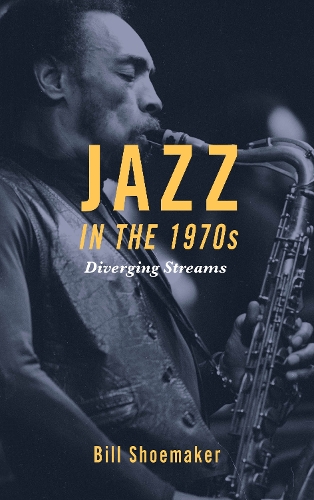
Jazz in the 1970s: Diverging Streams
(Hardback)
Publishing Details
Jazz in the 1970s: Diverging Streams
By (Author) Bill Shoemaker
Bloomsbury Publishing PLC
Rowman & Littlefield Publishers
20th December 2017
United States
Classifications
General
Non Fiction
Music reviews and criticism
Popular music
781.6509047
Physical Properties
Hardback
264
Width 160mm, Height 237mm, Spine 23mm
513g
Description
Breaking through pervasive misconceptions, Jazz in the 1970s explores a pivotal decade in jazz history. Many consider the 1970s to be the fusion decade, but Bill Shoemaker pushes back against this stereotype with a bold perspective that examines both the diverse musical innovations and cultural developments that elevated jazz internationally. He traces events that redefined jazzs role in the broadband arts movement as well as the changing social and political landscape. Shoemaker immerses readers in the cultural transformation of jazz through: official recognition with events like Jimmy Carters White House Jazz Picnic and the release of The Smithsonian Collection of Classic Jazz; the market validation of avant-garde musicians by major record labels and the concurrent spike in artist-operated record labels and performance spaces; the artistic influence and economic impact of jazz festivals internationally; the emergence of government and foundation grant support for jazz in the United States and Europe; and the role of media in articulating a fast-changing scene. Shoemaker details the lives and work of well-known innovators (such as Art Ensemble of Chicago, Anthony Braxton and Sam Rivers) as well as barrier-breaking artists based in Europe (such as Derek Bailey, Peter Brtzmann and Chris McGregor) giving both longtime fans and newcomers insights into the moments and personae that shaped a vibrant decade in jazz.
Reviews
Focusing primarily on one figure or group of musicians for each year of the decade, Shoemaker looks at British and European musicians, including Han Bennink, Peter Brtzmann, Albert Mangelsdorff, Chris McGregor, John Stevens, Derek Bailey, and Evan Parker. Major American figures profiled are Julius Hemphill, Anthony Braxton, Archie Shepp, Cecil Taylor, and Sam Rivers. Shoemaker also discusses jazz criticism and the jazz canon, jazz festivals, and jazz at the White House. His explorations of the music and scenes of the musicians are thorough. This is a well-written and important book. Summing Up: Recommended. Upper-division undergraduates through faculty and professionals. * CHOICE *
In this informative, opinionated history, Shoemaker, a longtime jazz writer and critic, breaks down the 1970s by devoting each chapter of the book to a specific year. After the 1960sa decade Shoemaker hails as the genres most pivotaljazz was at a crossroads and seeking a new identity. Although jazz in the 1970s is often associated with the word fusion, it headed in multiple directions. Shoemaker focuses on what he believes are the decades important albums, including saxophonist Julius Hemphills Dogon A.D. and Art Ensemble of Chicagos Nice Guys, plus the establishment of major events such as the Montreux Jazz Festival and Jimmy Carters one-off White House Jazz Picnic. At times, this selective history reads like a series of lengthy record reviews interspersed with DownBeat and Melody Maker reviews from the era, accompanied by overwritten prose (Increasingly, Marsaliss subsequent recordings combine aspects of reverse engineering and discredited recapitulation theories in biology, which posits that an organisms development resembles the series of ancestral types). That said, Shoemaker does provide insight into major and independent record labels and the impact that sampler releases such as The Smithsonian Collection of Classic Jazz had on avant-garde and mainstream listeners. Shoemaker writes for the jazz connoisseur, and his work will disappoint mainstream readers in search of a more complete overview of this era of jazz. (Jan.) * Publishers Weekly *
Shoemakers work has two great strengths: rapid response and sense of detail befitting a journalist, coupled with a historians sense of scale and long view. * The New York City Jazz Record *
Bill Shoemaker examines a jazz decade when cultures collided and coalesced, then moved on. He shows what these processes meant for the music's future, while unfalteringly bringing the reader to some unsuspected conclusions. Revelatory, responsive and inspiring. -- Val Wilmer, author, As Serious as Your Life: The Story of the New Jazz
Can we make sense of the reality that was jazz in the 1970s The answer is yes. In this brilliantly researched book, Bill Shoemaker sorts out the layers of Afro-American self-determination, European identity, the market, and even Jimmy Carters great jazz event at the White House. -- Matthew Shipp, pianist and composer
Bill Shoemakers Jazz in the 1970s: Diverging Streams is a rich read. You'll want to listen to the music as you follow the stories of the musicians, the business, and the dynamic interplay with history, culture, politics, and economic forces. -- Mark Dresser, bassist, composer, and professor, University of California San Diego
Author Bio
Bill Shoemaker is the coauthor of Arrivals/Departures: New Horizons in Jazz. He founded the online journal Point of Departure in 2005.
